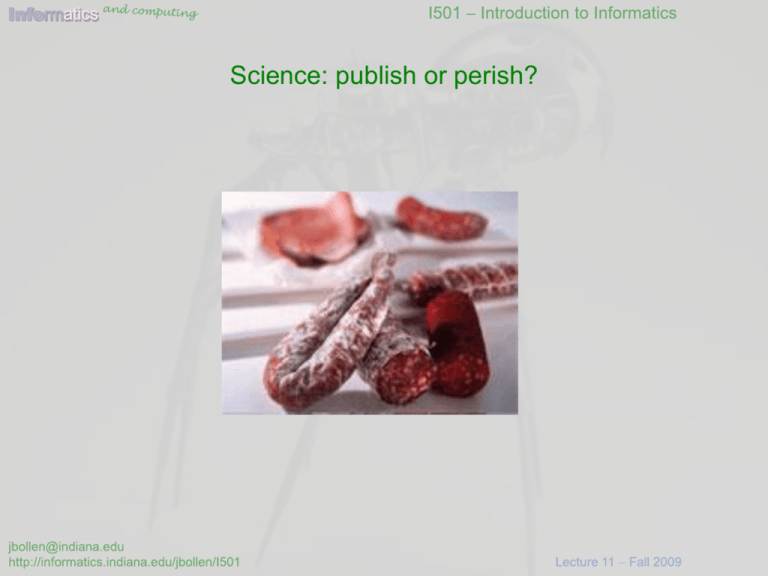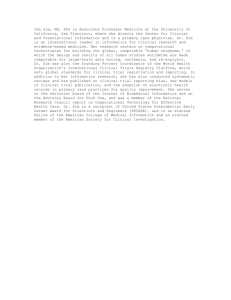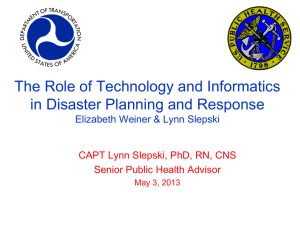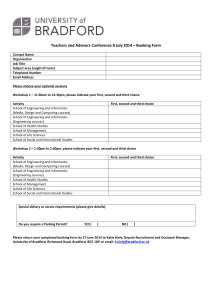here - Informatics
advertisement

Informatics Science: publish or perish? Informatics That’s it! Let’s talk about final assignment (once more): Your mission: Write a properly formatted and structured pre-proposal, as if to submit it to the NSF Program: Cyber-Enabled Discovery and Innovation (CDI). This research pre-proposal should be developed in consultation with an appropriate faculty member, and should focus on a Computational Thinking approach to a research question. URL: http://www.nsf.gov/pubs/2008/nsf08604/nsf08604.htm NEW Deadline: Friday, December 18th, 17:00 EST Informatics Submission Submit via email sent to jbollen@indiana.edu PDF format Grading: I will act like fastlane + program director + review panel combined (see picture below)! - Proper formatting: page limits, margins - Content: appropriate for CDI, formal requirements, etc fulfilled - Review panel: I will review like I otherwise review proposal and papers: Informatics Your proposal Please consult: http://www.nsf.gov/pubs/2008/nsf08604/nsf08604.htm#prep What you need to submit to me: 1) A 1 page summary. Must include broader impact and scientific merit statements 1) 5 pages of pre-proposal itself + 1 page for references Description (exclusive of list of participants, must not exceed 5 pages): Describe the scope of the project, including: the research and/or education agenda that promises paradigm-shifting advances in more than one field of science or engineering; a compelling rationale for how innovations in, and/or innovative use of, computational thinking will yield the desired project outcomes; and, a description of the intellectual partnership on which the project is based.” References Cited (1-page limit): Cite references relevant to the research and education plan Informatics Your proposal Proposed structure (you don’t have to use this): 1) 2) 3) 4) Problem statement: 1) What problem will your research address? 2) Context, relevance of problem Background: 1) Explain scientific “context” of proposed work 2) Existing approaches, their problems/promises 3) How your work fits into existing work and brings about scientific innovation Detail proposed work 1) Explain the substance and planning of your approach (make sure to address “computational focus” 2) Work and research plan (project phases) 3) Outcomes and deliverables 4) Team involved, explain interdisciplinary aspect Conclusion: 1) Possibly state broader impact and scientific merit 2) Discuss implications of research and where it could lead Multiple other arrangements would work; your choice Informatics Your proposal Ben Kovitz (List of funded projects) http://www.nsf.gov/awardsearch/progSearch.do?WT.si_n=ClickedAbstractsRecentAwards&WT.si_x=1&W T.si_cs=1&WT.z_pims_id=503163&SearchType=progSearch&page=2&QueryText=&ProgOrganizatio n=&ProgOfficer=&ProgEleCode=7721,7722,7725,7750,7751&BooleanElement=true&ProgRefCode= &BooleanRef=true&ProgProgram=&ProgFoaCode=&RestrictActive=on&Search=Search#results “A competitive CDI proposal will Describe an ambitious research and/or education agenda that, through computational thinking, promises paradigm-shifting advances in more than one field of science, engineering, or education Provide a compelling rationale for how innovations in, and/or innovative use of, computational thinking will yield the desired project outcomes; and Draw on productive intellectual partnerships that capitalize upon knowledge and expertise synergies in multiple fields or sub-fields of science, engineering, or education, and/or in multiple types of organizations, including academic, for-profit, and not-for-profit entities, both foreign and domestic.” Informatics Where to publish? Variety of venues available: - Conference proceedings: - Relatively fast, strict deadlines - Focus on recent contributions - Potentially high impact (CS) - Chance to present your paper and discuss with audience of peers - Journals: - Focused on particular domain - No deadlines, generally slower than conference proceedings - Potentially very high impact that is “officially” documented in various indicators, e.g Impact Factor, “tiers” - Great archival value Informatics Alternative publishing models Stevan Harnad in “For Whom the Gate Tolls” (2003) sketches following doomsday scenario: 1. A brand-new PhD recipient proudly tells his mother he has just published his first article. She asks him how much he was paid for it. He makes a face and tells her "nothing," and then begins a long, complicated explanation… 2. A fellow-researcher at that same university sees a reference to that same article. He goes to their library to get it: "It's not subscribed to here. We can't afford that journal. (Our subscription/license/loan/copy budget is already overspent)” 3. An undergraduate at that same university sees the same article cited on the Web. He clicks on it. The publisher's website demands a password: "Access Denied: Only pre-paid subscribing/licensed institutions have access to this journal.” 4. The undergraduate loses patience, gets bored, and clicks on Napster to grab an MP3 file of his favourite bootleg CD to console him in his sorrows. 5. Years later, the same PhD is being considered for tenure. His publications are good, but they're not cited enough; they have not made enough of a "research impact." Tenure denied. 6. Same thing happens when he tries to get a research grant: His research findings have not had enough of an impact: Not enough researchers have read, built upon and cited them. Funding denied. 7. He decides to write a book instead. Book publishers decline to publish it: "It wouldn't sell enough copies because not enough universities have enough money to pay for it. (Their purchasing budgets are tied up paying for their inflating annual journal subscription/license/loan costs...)” 8. He tries to put his articles up on the Web, free for all, to increase their impact. His publisher threatens to sue him and his server-provider for violation of copyright. 9. He asks his publisher: "Who is this copyright intended to protect?" His publisher replies: "You!" What is wrong with this picture? (And why is the mother of the PhD whose give-away work people cannot steal, even though he wants them to, in the same boat as the mother of the recording artist whose non-give-away work they can and do steal, even though he does not want them to?) Informatics Alternative publishing models Harnad: 1. All published materials will soon be available online 2. Linked according to citations, keyterms, content, authors, annotations 3. Increased self-correction, interactivity and productivity, even new metrics of impact 4. One hurdle: present “Subscription/Site-License/Pay-Per-View (S/L/P)” publishing model Appropriate for commercial content where author expects to be paid: content must be protected. NOT appropriate for scholarly communication where authors insist to give away content, in exchange for impact. Challenge to existing publishing business model: - based on “non-give away” publishing - significant changes since publication of this “resolution” Informatics Five crucial distinctions Harnad, again: 1. Distinguish the non-give-away literature from the give-away literature • Scientists want to give away content (gift economy) • Seek impact 2. Distinguish income (arising from article sales) from impact (arising from article use) • Scientist do not derive income from publications • Income derives from impact -> reads/cites/etc 3. Distinguish between copyright protection from theft-of-authorship (plagiarism) and copyright protection from theft-of-text (piracy) • “Theft of text” is desired by scientists • “Theft of authorship”: ultimate scientific crime 4. Distinguish self-publishing (vanity press) from self-archiving (of published, refereed research) • When you publish unrefereed materials on your web site vs. • Making refereed, quality-controlled materials available 5. Distinguish unrefereed preprints from refereed postprints • Preprints: unrefereed, no quality control, freely available • Refereed postprints: freely available but peer-reviewed and archived elsewhere (journal) Informatics Open-Access publishing Open-acces: removing access barriers • Subscription fees • Institutional restriction • Owner-ship regulations Why is this an issue? For profit publishers: - quality control, i.e. peer review - publish materials that they own (=your papers) - costs are recovered from charging access fees or other Today: - electronic publishing has become standard; it’s cheap - only expense is quality control but peer review is conducted by reviewers (you and I), so only logistics/organization remains Can organization be altered so that access becomes free and costs are born elsewhere than at access point, hence “open access”? Harnad: “immediate, permanent, toll-free online access to the full-texts of peer-reviewed research journal articles.” Informatics Open-Access publishing Different Routes to Open Access: • “Gold”: journals providing free access • Pre-emptive payment of publication fees by author, institution • Gradual access of publications > x months • “Green”: self-archiving by authors • Web sites • Archival web sites, e.g. arXiv • Institutional repositories (mandates) Examples: • Biomed Central: http://www.biomedcentral.com • pioneer in OA publishing • fully peer-reviewed • 205 journals! • Public Library of Science: http://www.plos.org/ • not for profit OA publisher • Biology, Medicine, Computational Biology, Genetics, Pathogens, ONE, Neglected Tropical Diseases Informatics Open-Access publishing: my take Without a doubt, best option • Rigorous peer-review in many cases • Often very fast turn-around • But most importantly: EVERYONE can access Latter is tremendous advantage: • More eyeballs, more reads, more cites; it works! • Allows papers to have impact well-beyond traditional academic circles Is it perfect? No. Most high-impact journals in your domain are not open-access Many open-access journals are young: - have not yet demonstrated their value among your peers and supervisors - PLoS ONE good case in point: Impact Factor absent? Projected to be about 3-4 and growing, could be higher Transitional: Self-arxiv at arxiv.org, even immediately after submission Be careful though with journals that take embargo times seriously like Nature and Science




